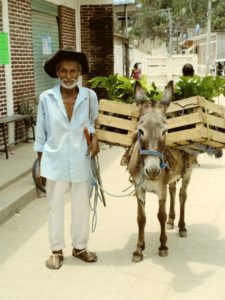Since Cristobal Colon´s travel to America, the original inhabitants from those territories start to become minorities in every country they lived.
Costa Rica instead still has 8 aboriginal groups living according to their own cultures.
According to the 2000 census, the Costa Rican aborigines conform 1.7% of the countries population with 63,876 people, most of them are young below 18 years and just 4% have more than 65 years of age.
The majority of them live in rural areas of Puntarenas and Limón, in Talamanca 60% of the inhabitants are aborigines, which is also one of three territories with more poverty in Costa Rica.
In spite that many of them are artesans, and other are skilled technitians or profesionals in some industries, these groups have a high poverty level, with many difficulties for obtaining basic services such as electricity, water, health and education.
Most of those problems exist because of geographical distances, speaking only their native tounges and little to no spanish thus provoking their marginalization from national state sponsored support and aid programs.
But this situation was not always like this. At first the “Chorotegas” who use to live at the north of Costa Rica, had been influenced by Mayas and Aztecas cultures.
On the Guanacaste zone there existed the dividing line between north and south cultures. In Costa Rica’s museums there are many ceramic artifacs that tell the history about the ancestral days.
Many objects from the aboriginal people of Costa Rica, were made with gold, obtained from river sands. Things like tiaras, bracelets, disc and pectorales are evidence from those eras.
Also goldsmith’s pieces like fish, crabs, turtles, jaguars, frogs and other kinds of animals represent their relationship with the nature and the respect they had to it.
Another material they used to work was Jade, witch they considered more valuable than gold, and also gave them medicinal powers.
Let`s meet the actual existing tribes:
Bibrís: They live at Salitre and Cabagra on the Buenos Aires zone. Preserving there own language and writting system. They cultivate corn, beans and vegetables and also farm pigs, birds and go fishing.
They move on boats in the Sixaola river. The Bibris are the biggest comunity of aborigines in the country.
Cabécares: located on Chirripó at Pacuare valley, they live in the montains. They have kept their cultural identity, speaking their own language and preserving traditions and habits. They cultivate coffee, cocoa, bananas and beans, and also go fishing and hunting.
Ngäbes (Guaymíes): Coming from Panamá, these people also have a relative large population. They can be found at Abrojos (Corredores), Conreburica (Golfito) and Coto Brus, all of them at the Puntarenas área.

They preserve physical caracteristic like there traditional costumes. They combine hunting and agriculture for their substainance.
Guatusos o Malekus: They are located at the north of the country, on Alajuela providence. Have a bilingual education on spanish and maleku language.
As an artesan comunity they make aboriginal figures on ceramic, wood articles, bows and arrows
Borucas o Bruncas: They have lost their language and traits. Making cotton clothing witch they color using natural dyes.
They are knows for the “Baile de los Diablitos” witch is a traditional dance performed every year on December 31st.
Térrabas: They have lost most of there own caracteristics as their language and territory, nowdays nonaboriginal farmers live among them.
They farm corn, beans, rice, banana and citrics.
Huetares: A little comunity living at San Jose providence. Their culture and physical traits have been lost in present times.
They survive thanks to the artesanal activities with vegetable fibers and because they’re experts making vegetables dyes to paint fabrics. Also elaborating ceramic products.
Chorotegas: Living at Guanacaste providence, this small comunity, has lost the language because the influence from local farmers.
They sow beans, fruits and vegetables and exploit bee keeping. Also maintain the tradition of ceramic pots elaboration.
Miskitos y Sumos: They have seminómad kind of life. Keeping their dialect and traditions arising form a rich afrocaribean influence.
Teribes: Coming from Panama, some Teribes families have live at Yorkín and Sixaola zone. Farming beans and also go fishing and hunting. They keep their own language and traditions.
